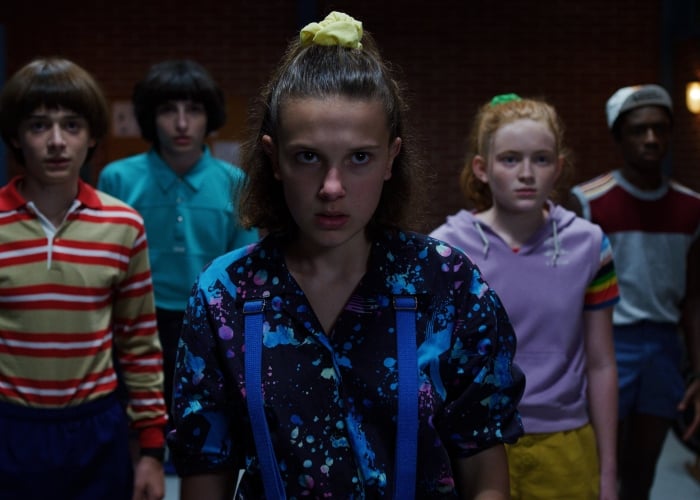For the past two seasons, Netflix’s Stranger Things has served the masses a perfect slice of ’80s-inspired sci-fi nostalgia. It was scary, but not so scary it couldn’t be watched as a family. It was laced with throwbacks for the parents and had a charming tween cast that drew in young viewers. It was a hit in all quadrants, even if it sometimes felt so crowd-pleasing and comfortable that it may as well have been engineered in a lab like the one that once held Eleven (Millie Bobby Brown).
That was then, and this is now. In season three of Stranger Things, shit gets real. This isn’t to say the show is more realistic–there are action sequences in these eight new episodes that definitely stretch belief–but that the story we loved is now expanding beyond its original premise boldly and continuously, in ways that sometimes make the new season seem like a different series altogether. School’s out for the summer. There are teens who won’t stop making out. There are shockingly gory death sequences and mortal threats that seem jarringly human despite their supernatural source. There are massive tonal shifts and directorial risks and long stretches that don’t seem to lean on homage or reference at all. Like it or not, Stranger Things is growing up.
The inevitability of change is one major topic on the Duffer brothers’ minds this time around, and it’s easy to see why. The show’s younger cast members seem to be growing by the day, a fact made obvious by continual flashbacks to earlier seasons. Rather than write them as mostly static adventure-seeking heroes, the Duffers and their writing team imagine them as angsty, funny, sometimes annoying teens who have evolved past cute one-liners. The girls–Max (Sadie Sink) and El –question their autonomy and desires over issues of Tiger Beat, while some of the boys–Mike (Finn Wolfhard), Lucas (Caleb McLaughlin), and Will (Noah Schnapp)–abandon the simple joys of tabletop games to focus on their tricky feelings of shame, frustration, and confusion about dating and friendship. Brown is excellent as always as former human experiment Eleven, but she’s only one part of the story, now, not it’s heart.
There’s also a lot of bickering this season, among both teens and adults, and at times–specifically in one or two sagging middle episodes–the discord threatens to derail the spirit of excitement that usually permeates the show. Despite this, the good largely outweighs the bad. This season’s score by Kyle Dixon and Michael Stein is an eerie delight, the pop culture references are well-placed and mostly not cringeworthy, and long-awaited character payoffs come early and often. Plus, the Duffers are three for three on perfect endings; the new season comes together brilliantly in a sequence of heart-poundingly intense final episodes packed with surprises that might just break the internet.
The first half of season three sees the characters divided into as many as five different groups, each one exposed to a different fishy situation–sick rats, broken fridge magnets, and the like–that may be related to the latest thing going bump in the night in Hawkins. Two storylines see key characters dipping into major action-comedy territory (David Harbour has cited Fletch as a surprising inspiration for his and Winona Ryder’s plot this season), while the show manages to pile on more horror elements than ever, drawing monster design inspiration from classics like The Thing and Invasion of the Body Snatchers, along with the body horror of David Cronenberg’s filmography. The season is darker and sadder than past outings but has more levity throughout as well. Some storylines land better than others, with the mall-set dream team of Steve (Joe Keery, at this point by far the most effortlessly entertaining cast member), Dustin (Gaten Matarazzo), Lucas’s little sister Erica (Priah Ferguson), and scene-stealing newcomer Robin (Maya Hawke) faring best of all.
By shelving many of the mythology elements that connected the first two seasons in favor of exploring a new conspiracy, the series is able to work as a nearly stand-alone saga that bends and blends multiple genres. It’s part coming-of-age drama, part spy thriller, part ensemble comedy, part gross-out horror, and although the disparate genres don’t always fit cleanly together, the overall impression is of a series that’s finally broken free of the nostalgia factory formula.
On top of all that, the series seems to stand on surer moral ground than it has in the past. Gone are the moments of cliched teen jealousy or outdated good-versus-bad-boy tropes, and in their place are varied examinations of identity, perhaps with extra emphasis on masculinity. We see Billy’s (Dacre Montgomery) bullying dad, Mike’s distracted family, Will’s absent father, and Hopper’s (Harbour) well-meaning yet blustering and booze-soaked parenting style. Although the Duffers don’t explicitly connect all these dots, there’s a Stephen King-esque focus on the ways in which humans, too, can be monstrous. Violent metaphors and actual violence abound, and this time there’s no easy key to winning hidden in the pages of the kids’ Dungeons and Dragons rulebook.
Since its debut, Stranger Things has been one of the purest delights on television, and despite a few growing pains, this season of change continues to please. With Game of Thrones gone, there’s been a lot of talk about the end of communal watching experiences, but at this point, Stranger Things is more or less a big-budget summer blockbuster we can all watch at home simultaneously. So for eight hours this summer, let’s all visit Hawkins, Indiana; there’s no place I’d rather be.

